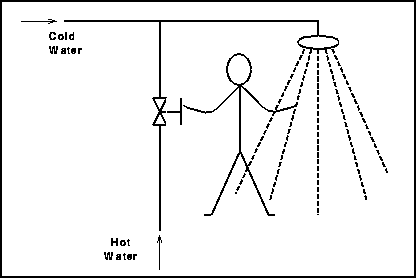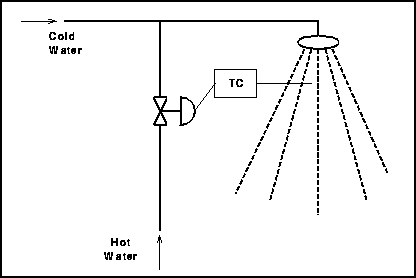The key characteristic of control is to interfere, to influence or to modify the process. This control function or the interference to the process is introduced by an organization of parts (including operators in manual control) that, when connected together is called the Control System . Depending on whether a human body (the operator) is physically involved in the control system, they are divided into Manual Control and Automatic Control . Due to its efficiency, accuracy and reliability, automatic control is widely used in chemical processed.
The aim of this section is to introduce the concept of control systems, what their function is and what hardware and software is required by them.
Manual Control System
First start with a simple manual control system, to examine how control is introduced, how the control system is constructed and how it works.
A diagram of the system is shown below.

To begin with the shower is cold. To start the heating process the valve in the hot water line is opened. The operator can then determine the effectiveness of the control process by standing in the shower. If the water is too hot, the valve should be closed a little or even turned off. If the water is not hot enough then the valve is left open or opened wider.
Functions of a Control System
It can be seen that this control system, completed by the operator, possesses the following functions:
* Measurement
This is essentially an estimate or appraisal of the process being controlled by the system. In this example, this is achieved by the right hand of the operator.
* Comparison
This is an examination of the likeness of the measured values and the desired values. This is carried out in the brain of the operator.
* Computation
This is a calculated judgment that indicates how much the measured value and the desired values differ and what action and how much should be taken. In this example, the operator will calculate the difference between the desired temperature and the actual one. Accordingly the direction and amount of the adjustment of the valve are worked out and the order for this adjustment is sent to the left hand from the brain of the operator. If the outlet water temperature is lower, then the brain of the operator will tell the left hand to open the steam valve wider. If there is any disturbance, or variation of flow rate in water to the shower inlet, some adjustment must be made to keep the outlet water temperature at a desired value.
* Correction
This is ultimately the materilisation of the order for the adjustment. The left hand of the operator takes the necessary actions following the order from brain.
Therefore, for a control system to operate satisfactorily, it must have the abilities of measurement, comparison, computation and correction.
Of course, the manual operation has obvious disadvantages e.g. the accuracy and the continuous involvement of operators. Although accuracy of the measurement could be improved by using an indicator, automatic control must be used to replace the operator. In industry, it is automatic control that is widely used.
Automatic Control System
Based on the above process, we can easily set up an automatic control system as shown in the next figure.

- Firstly, we can use a temperature measurement device to measure the water temperature, which replaces the right hand of the operator. This addition to the system would have improved accuracy.
- Instead of manual valves, we use a special kind of valve, called a control valve, which is driven by compressed air or electricity. This will replace the left hand of the operator.
- We put a device called a controller, in this case a temperature controller, to replace the brain of the operator. This has the functions of comparison and computation and can give orders to the control valve.
- The signal and order connections between the measurement device, control valve and controller are transfered through cables and wires, which replace the nerve system in the operator.
Hardware of a Control System
Examining the automatic control system, it is found that it contains the following hardware.
- Sensor - a piece of equipment to measure system variables. It serves as the signal source in automatic control. These will be discussed at length in a later module.
- Controller - a piece of equipment to perform the functions of comparison and computation. The actions that a controller can take will be discussed at length in a later module.
- Control Element - a piece of equipment to perform the control action or to exert direct influence on the process. This element receives signals from the controller and performs some type of operation on the process. Generally the control element is simply a control valve.
Software of a Control System
Associated with a control system are a number of different types of variables.
First we have the Controlled Variable . This is the basic process value being regulated by the system. It is the one variable that we are specially interested in - the outlet water temperature in the example above. In feedback control the controlled variable is usually the measured variable .
An important concept related to the controlled variable is the Setpoint . This is the predetermined desired value for the controlled variable. The objective of the control system is to regulate the controlled variable at its setpoint .
To achieve the control objective there must be one or more variables we can alter or adjust. These are called the Manipulated Variables . In the above example this was the input hotwater flow rate.
Conclusively, in the control system we adjust the manipulated variable to maintain the controlled variable at its setpoint . This meets the requirement of keeping the stability of the process and suppressing the influence of disturbances.